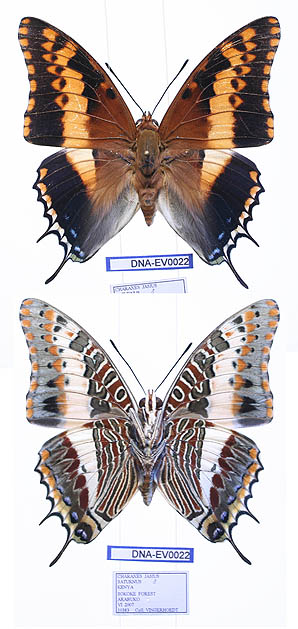
Celaenorrhinus is a genus of skipper butterflies which are commonly termed sprites. An alternate name is flats, for their habit of holding their wings flat when resting, but this is also used for related genera. They are the type genus of tribe Celaenorrhinini.

The Hesperiini or branded grass skippers are a tribe in the Hesperiinae subfamily of skipper butterflies. They are known as branded grass skippers because all the males in this tribe feature a black diagonal brand of scales on their forewings that exude pheromones to attract females.

Hasora khoda, the large banded awl, is a butterfly belonging to the family Hesperiidae which is found in India, parts of Southeast Asia and Australia.

Choaspes plateni, commonly known as the branded awlking, is a species of butterfly belonging to the family Hesperiidae. It is found in Asia. Known food plants include Meliosma (Meliosmaceae) and Pometia (Sapindaceae)

Choaspes xanthopogon, the similar awlking, is a species of butterfly belonging to the family Hesperiidae.

Capila pieridoides, commonly known as the white dawnfly, is a species of hesperid butterfly found in India and Southeast Asia.

Callimormus is a genus of skippers in the family Hesperiidae.

Chamunda chamunda is a species of spread-winged skipper in the family Hesperiidae. It is the only species in the monotypic genus Chamunda and the monotypic subfamily Chamundinae. It is found from Assam to Burma, Thailand, Laos, Peninsular Malaysia and possibly Java.

Dalla is a genus of skippers in the family Hesperiidae.

Heliopetes is a Neotropical genus of spread-winged skipper butterflies in the family Hesperiidae.
Iliana is a genus of skippers in the family Hesperiidae. It was first described in 1937 by Ernest Layton Bell, with Iliana romulus as the type species. Species of the genus have a neotropical distribution.
Piruna is a genus of skippers in the family Hesperiidae.
Tigasis is a Neotropical genus of grass skippers in the family Hesperiidae.

Taractrocera danna, the Himalayan grass dart, is a butterfly of the family Hesperiidae. It is found in the Himalayas, from Kashmir through Nepal, southern Tibet and Sikkim to Bhutan. In Nepal, it is found on heights between 4,500 and 13,000 feet.

The Erionotini are a tribe of skipper butterflies in the subfamily Hesperiinae.

Caenides dacela, commonly known as the common recluse, is a species of butterfly in the family Hesperiidae. It is found within the geographical range that stretches from the Basse Casamance in Senegal to Uganda and Kenya, but generally does not penetrate much south of the Equator.

Moncina is a subtribe of butterflies in the skipper subfamily Hesperiinae.

Charaxes saturnus, the foxy charaxes or koppie charaxes, is a butterfly that flies through most of the Savannah of the Eastern and Southern Afrotropical realm, and also occurs in suitable forest habitat locations including the forest belt of west-central Africa.












